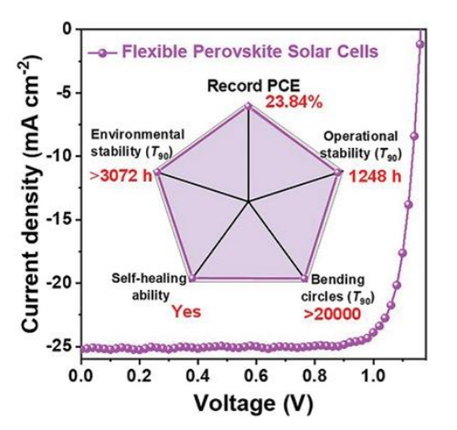Perovskite Grain-Boundary Manipulation Using Room-Temperature Dynamic Self-Healing “Ligaments” for Developing Highly Stable Flexible Perovskite Solar Cells with 23.8% Efficiency
Ziyuan Chen 1 , Qinrong Cheng 1 , Haiyang Chen 1 , Yeyong Wu 1 , Junyuan Ding 1 , Xiaoxiao Wu 1 , Heyi Yang 1 , Heng Liu 2 , Weijie Chen 1 , Xiaohua Tang 1 , Xinhui Lu 2 , Yaowen Li 1, 3, 4,*(李耀文) , Yongfang Li 1, 3, 5
1 Laboratory of Advanced Optoelectronic Materials, Suzhou Key Laboratory of Novel Semiconductor-Optoelectronics Materials and Devices, College of Chemistry, Chemical Engineering and Materials Science, Soochow University, Suzhou, 215123, China.
2 Department of Physics, Chinese University of Hong Kong, New Territories, Hong Kong, 999077, China.
3 Jiangsu Key Laboratory of Advanced Negative Carbon Technologies, Soochow University, Suzhou, 215123, China.
4 State and Local Joint Engineering Laboratory for Novel Functional Polymeric Materials, Jiangsu Key Laboratory of Advanced Functional Polymer Design and Application, College of Chemistry, Chemical Engineering and Materials Science, Soochow University, Suzhou, 215123, China.
5 Beijing National Laboratory for Molecular Sciences, CAS Key Laboratory of Organic Solids, Institute of Chemistry, Chinese Academy of Sciences, Beijing, 100190, China.
Adv. Mater. 2023, 2300513
Flexible perovskite solar cells (pero-SCs) are the best candidates to complement traditional silicon SCs in portable power applications. However, their mechanical, operational, and ambient stabilities are still unable to meet the practical demands because of the natural brittleness, residual tensile strain, and high defect density along the perovskite grain boundaries. To overcome these issues, a cross-linkable monomer TA-NI with dynamic covalent disulfide bonds, H-bonds, and ammonium is carefully developed. The cross-linking acts as “ligaments” attached on the perovskite grain boundaries. These “ligaments” consisting of elastomers and 1D perovskites can not only passivate the grain boundaries and enhance moisture resistance but also release the residual tensile strain and mechanical stress in 3D perovskite films. More importantly, the elastomer can repair bending-induced mechanical cracks in the perovskite film because of dynamic self-healing characteristics. The resultant flexible pero-SCs exhibit promising improvements in efficiency, and record values (23.84% and 21.66%) are obtained for 0.062 and 1.004 cm2 devices; the flexible devices also show overall improved stabilities with T90 >20 000 bending cycles, operational stability with T90 >1248 h, and ambient stability (relative humidity = 30%) with T90 >3000 h. This strategy paves a new way for the industrial-scale development of high-performance flexible pero-SCs.

链接://onlinelibrary.wiley.com/doi/full/10.1002/adma.202300513